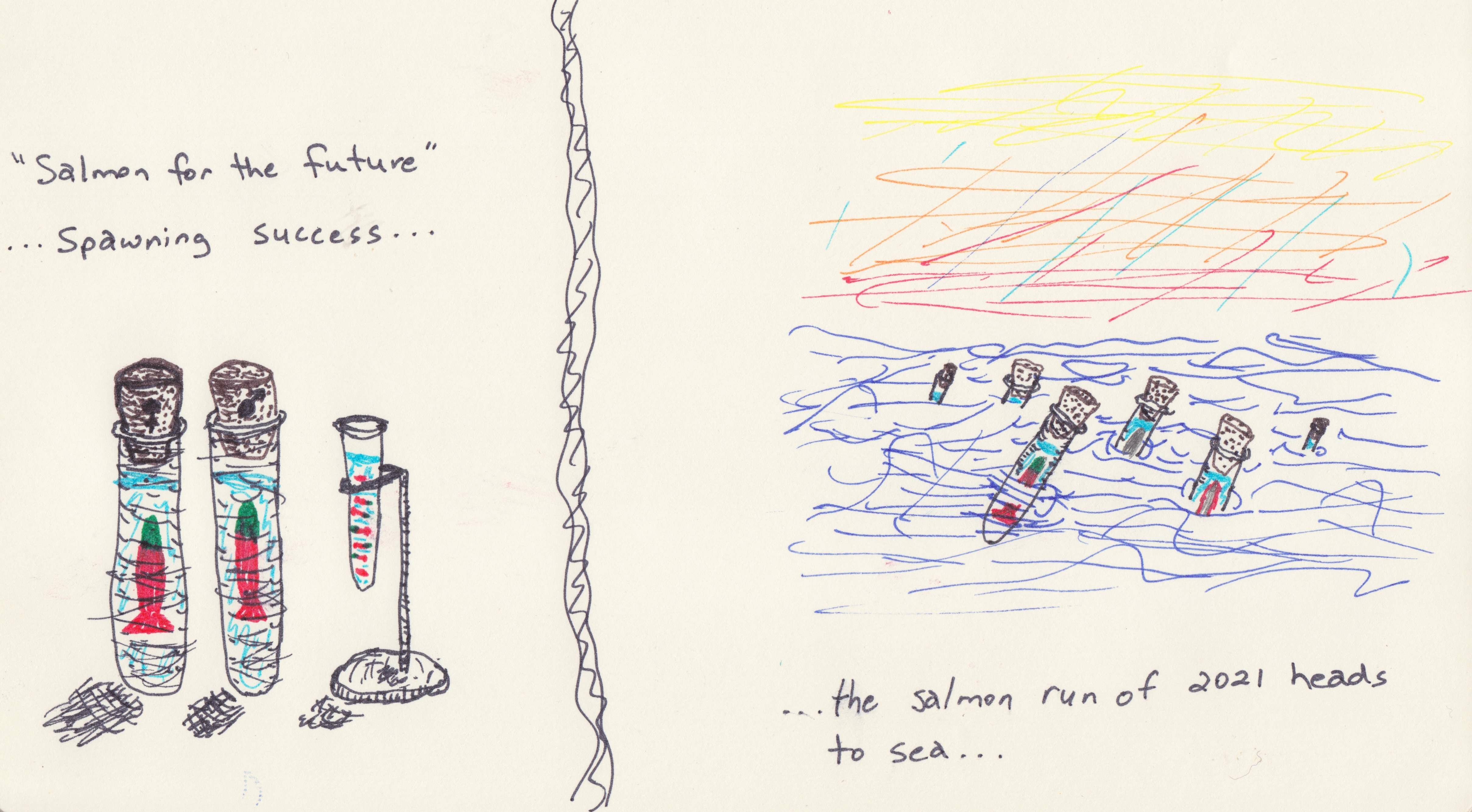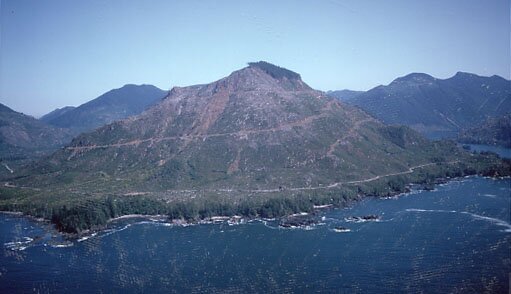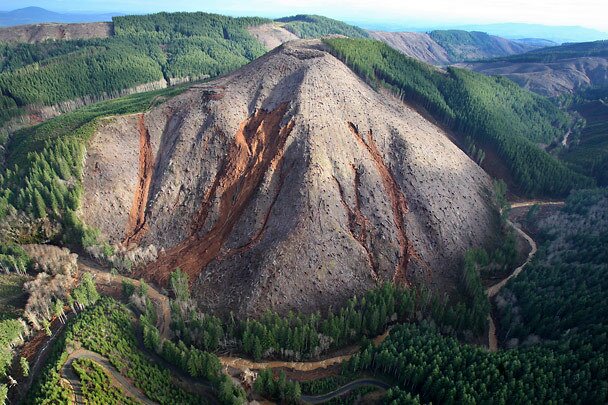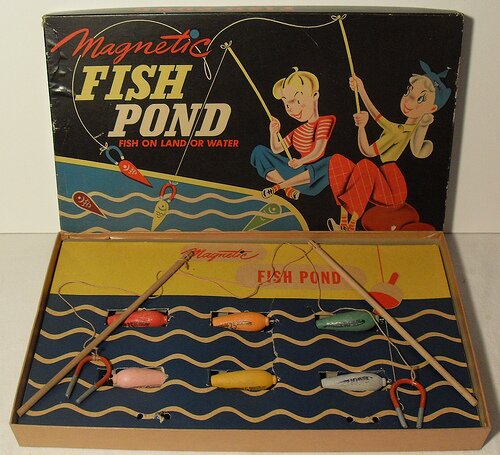.
Another salmon article from Mark Hume last week in the Globe and Mail:
Carol Schmitt got up early for the move because she had a lot to pack – 48,500 live salmon to be exact.
Luckily she had rented a semi-trailer tanker truck the night before, sterilizing it so the fish could safely be transported from the Omega Pacific Hatchery, near Port Alberni, to the Sarita River, on the west coast of Vancouver Island.
The fish – precious not only because Chinook are endangered in many places in British Columbia, but also because they are part of a bold experiment – had to be handled with care.
Unlike millions of salmon that are being released from Department of Fisheries and Oceans hatcheries in B.C. this spring, Ms. Schmitt’s fish have been held almost one year longer and grown more slowly, to mimic conditions in nature.
“Mimic conditions in nature”… hmmmmm….
Here’s the photo that accompanies the online story:
So are the two people in the photo mimicking trees?
Or, are they mimicking the kingfishers in the trees that love to eat baby Chinook?
Or the multitude of other birds that love baby salmon?
No disrespect intended towards Ms. Schmitt or others involved in the article… I can understand the excitement of the project…
However, let’s just keep things in perspective.
I’m sure many folks out there remember the time when the forest industry sold clearcuts as simply “mimicking natural disturbances”…
Like this clearcut on west coast Vancouver Island:
Just like nature makes it… (this isn’t all that far from the areas where these test-tube Chinook are to be released on west-coast Vancouver Island in this “bold experiment”)
Or this string of photos from a Seattle Times article a few years ago. This is the great logging empire Weyerhaueser mimicking nature…
And no worries, I’m sure that’s not a salmon stream at the bottom.
And this from a story out of the Everett, WA newspaper in 2008 when the Chehalis River flooded in epic proportions. (don’t worry probably not a salmon stream either… anymore…)
just "natural"
_ _ _ _ _ _ _
The Globe and Mail article continues:
DFO releases Chinook from hatcheries at eight months of age. The fish are known as S-0s, because they are smolts, with less than one year in freshwater. Ms. Schmitt’s approach, perfected over decades growing salmon for B.C. salmon farms, is to keep the fish for 17 months, raising them in water as cold as the native stream from which their brood stock originated. And she restricts feed, so the fish mature more slowly. Those fish are known as S-1s and she believes such “stream type Chinook” are the key to the restoration of wild salmon populations in B.C.
“If you raise them in warmer water and feed them lots, as DFO does, they grow bigger and faster, but you trigger ‘smoltification’ too soon,” Ms. Schmitt said.
Smoltification is when young salmon undergo dramatic physiological changes, turning from fry into smolts, as they adapt for the move from freshwater to salt water.
DFO’s Chinook look ready when they are released, but their immune systems aren’t fully evolved, she said – and most will die from vibriosis, a bacterial disease that attacks fish in salt or brackish water.
“I feel 85 to 90 per cent of federal S-0s are dead within four to six months,” Ms. Schmitt said.
The statistics appear to bear that out, as DFO typically gets only about 1 per cent of its hatchery salmon back as adults. On the Sarita River, only 500 Chinook spawners returned last year – 0.1 per cent of the fish DFO had released as S-0s four years earlier.
Ms. Schmitt, with whom DFO is working on an experimental trial of S-1s on three Vancouver Island rivers, said she is expecting returns of up to 10 per cent.
“If you ship those fish out as S-0s you are accelerating the decline of the river,” she said. “If you release them as proper S-1s, you will get three to ten times as many fish back.”
Ms. Schmitt said in Alaska, releases of S-1 Chinook have resulted in returns as high as 22 per cent.
“Can you imagine what returns like that would mean in B.C.?” she asked. “That would be incredible. It’s pretty exciting stuff.”
With funding support from DFO and four fish farm companies (Mainstream Canada, Marine Harvest Canada, Creative Salmon and Grieg Seafood), Ms. Schmitt is doing trial releases this week of about 100,000 salmon in the Sarita, Phillips and Nahmint Rivers. The first release was Wednesday.
She said it has been tough to get to this point, because DFO has been resistant to change. “Getting DFO to allow us to participate in enhancement has and continues to be a challenge.”
DFO was unable to provide a spokesman to talk about the Omega project.
_ _ _ _ _ _
There are so many things that strike me about this project and article… many of them striking a bit of a sour cord. Maybe this initiative will bear results… however the experiment of “salmon enhancement” for the last many decades has few ‘success’ stories. (the thing with interventions, is they generally become permanent…)
As you can probably already tell by the pounce on “mimicking nature” … Without knowing a lot more about this specific project… yet, about the only natural mimicking I can see is that the water is colder…
The rest truly is an “experiment”… and really how have our experiments with nature gone?
_ _ _ _ _
The ‘companies’ are having some difficulties getting acceptance. Yeah… well… there could be some ethical and other considerations that may need to be considered here.
When private companies start investing in producing fish; could they not rightly express some “ownership” of these fish when they return to spawn?
Or do these fish simply enter the common pool and become lead actors in that famous Shakespearean play “Tragedy of the Commons”…?
Not that I don’t doubt that companies can’t do altruistic, well-intentioned things; however, it does run against the flow of the corporate modus operandi… profit.
But then of course there is some social capital and goodwill gained in this type of effort… isn’t there?
And, don’t you know it… salmon farming companies need some good press these days; and not the kind that gets purchased in multi-million $$ PR campaigns…
_ _ _ _ _
Test-tube salmon “are the key to the restoration of wild salmon populations in B.C.“?
Last time I checked, ‘restoration‘ meant something like:
The return of something to a former owner, place, or condition.
This is about as much “restoration” as lipsosuction and a face lift is “restoration” to one’s youth…
It’s pretty tough to “restore” these sorts of things once they’re gone:
Or this:
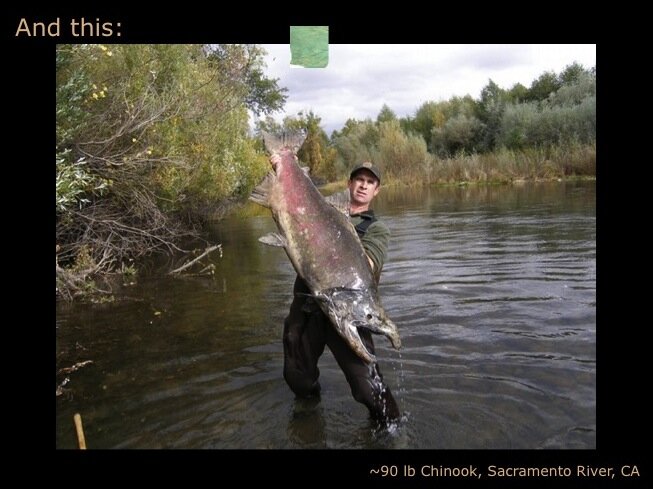 We really need to be careful when we start batting around terms like “restoration”…
We really need to be careful when we start batting around terms like “restoration”…
It’s important to ‘mean what we say and say what we mean’…
Hatchery interventions can be used to assist in rehabilitation of some areas… however, they can’t be a permanent solution.
Let’s for example look at some of the numbers quoted in the success of DFO’s enhancement efforts.
If they’re getting 0.1% return on investment… does that sound like a sound strategy? That’s worse returns then the common chequing account these days…
But then the initial goals of the Salmon Enhancement Program were:
The Salmonid Enhancement Program (SEP) was established in 1977 with objective of restoring stocks of salmon to their historic levels of abundance.
How’s that going?
_ _ _ _ _ _
Making comparisons to Alaskan returns, just isn’t going to cut it.
Different practices (e.g. ocean ranching); different migration patterns; different investments; different priorities.
Seems its convenient in situations like test-tube salmon babies to forget the issues in the ocean — e.g. lower productivity, etc. — but when it comes to judicial inquiries, fisheries ‘management’, etc. then all of a sudden the discussion of poor ocean conditions and the like become prevalent.
(is that because it makes easier… rather than looking in a mirror… and at history)
At some point we need to make a choice on what the issues are…
For example, what’s the point of spending millions of dollars to send test-tube babies out to the ocean if productivity remains low…?
what’s the point of sending test-tube babies out to the wild if the streams they have to return to are largely clearcut to the banks…?
Go down to the Lower 48 and see what sort of success they’ve had at spending upwards of a billion $$ on salmon habitat rehab and hatcheries… ask how many fish they’re catching?
_ _ _ _ _
We are far past the point of “restoring” salmon.
Are we all that far off from basically preserving zoo populations and setting up kids fishing ponds…?
Rather than fumbling around trying to do better what nature already does perfectly (for millions of years) why don’t we clean up the mess we made in the first place?
The problem with salmon isn’t that they need “help” reproducing… they been doing that well before we came along. It’s more that if we’re all to co-exist; then we need to look after the neighborhoods that we co-exist in… for example: watersheds, rivers, lakes, and so on.
With the rapid changes coming due to climate change (less cold water, ocean acidification, water shortages, etc.)… wild salmon are going to need a lot of help making sure their neighborhoods are fit for spawning, dieing, and reproducing in.
Just like your neighborhood… pretty hard to spawn in a mudslide isn’t it?
(fun to wrestle in maybe… not so much fun after that…)

